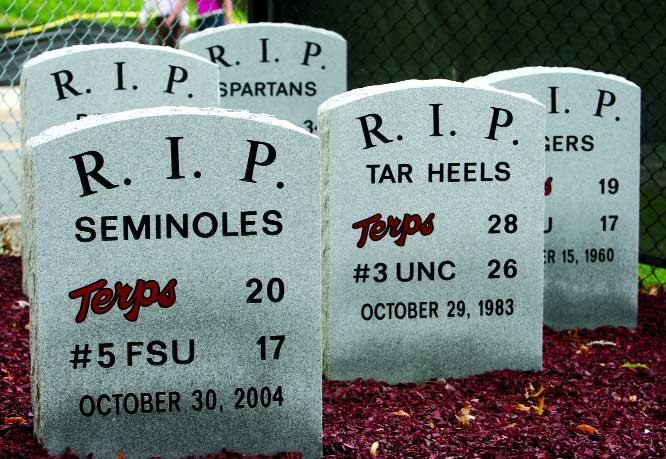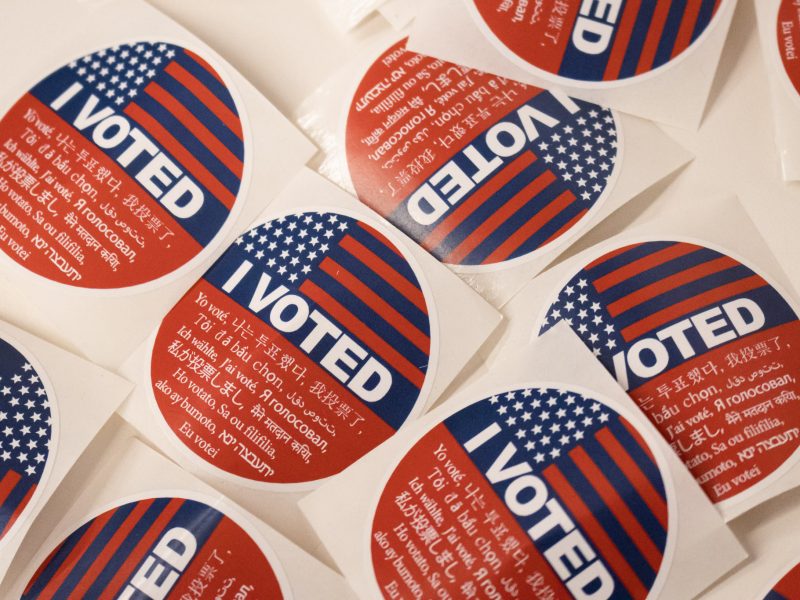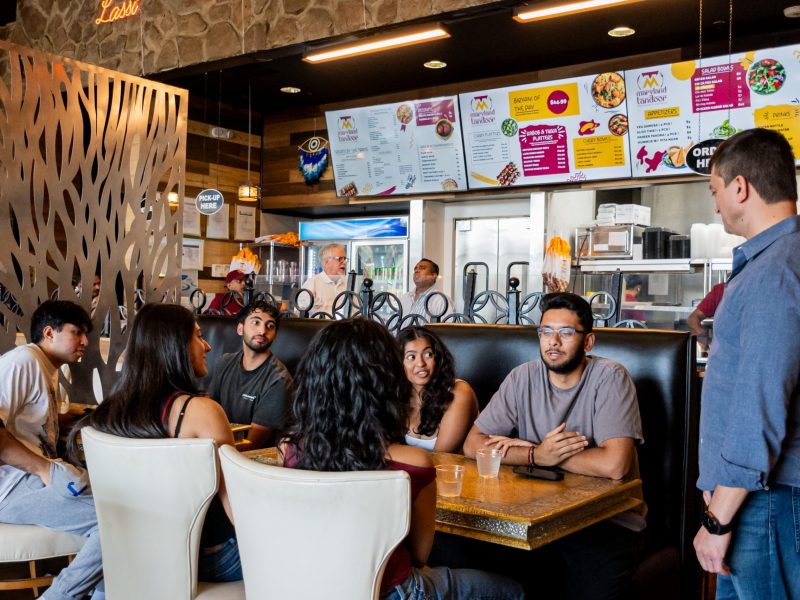
Eight engraved tombstones were placed near the football team’s practice field this summer to commemorate wins over top-10 teams and inspire the players.
At halftime of the Terrapins’ Nov. 10, 1984, game against Miami, it seemed the only appropriate way to commemorate the game’s end was with a funeral.
The sixth-ranked Hurricanes had stormed out to a 31-0 lead on their home field behind the play of quarterback Bernie Kosar, and there appeared to be no looking back.
But the Terrapins rallied for 42 points in the second half with the help of quarterback Frank Reich, who helped engineer the greatest comeback in NCAA Division I-A history.
The tombstone reads: “R.I.P. Hurricanes. Terps 42, #6 Miami 40.”
Twenty years after the joyous outcome, the game has been laid to rest as part of the Top-10 Graveyard: Eight stone markers now occupy a graveyard at the entrance to the football practice fields along Stadium Drive, installed in April to begin a new athletic tradition.
Tom Deahn, director of football operations, originally came up with the idea for the graveyard after last season’s game at Clemson, when he saw their own version of the graveyard, where a tombstone is placed to mark road victories over ranked opponents. The tradition is intended to remind current Terrapins of their past conquests against teams that were in the national top-10 at the time of the game.
Deahn said he proposed the idea to head coach Ralph Friedgen, who gave the project his blessing.
“Our whole idea was to put it somewhere the players would have to walk past it and remind them that, to be the best, you have to beat the best,” Deahn said.
Other games commemorated by the tombstones include a 1955 defensive battle between the third-ranked Terrapins and top-ranked UCLA Bruins at Byrd Stadium, which Maryland won 7-0; a 28-26 victory over third-ranked North Carolina, which clinched the ACC title for the Terrapins in 1983; and last season’s 20-17 win over fifth-ranked Florida State.
No university funding was used in financing the project; the stones were paid for by the Maryland Gridiron Network, the official booster group of the Maryland football team.
The cost of the tombstones could not be obtained from MGN, but Anna Leytush, manager of Chesapeake Monuments in Baltimore, said headstones similar to the ones used in the graveyard would typically cost between $350 and $400 each.
Deahn said the placement of the tombstones was carefully thought out so they would be visible mainly to members of the Maryland football team.
“We had talked about even putting it right next to the sidewalk where the visiting teams would pass it right as they walk in, to hopefully maybe intimidate them,” Deahn said, “But Coach Friedgen felt that was probably not the best idea to do that. It’s more for our players and our players’ mindset than it is for the other team.”
Friedgen is aware of the impact that mockery can have on an opposing team’s mindset. Last year, he was in favor of banning “Rock and Roll, Part II” from being played at football games because he said taunting another team only fires them up.
“Everybody we play nowadays is good enough,” Deahn said, “They don’t need any extra motivation.”
On a campus where debates over sportsmanship have been front and center over the past year, at least one faculty member sees a problem with using tombstones to symbolize victory on the field.
Greig Stewart, the executive director of College Park Scholars, said the tombstones may send the wrong message to students, fans and opponents.
“Gravestones are very representational objects, and people bring to those objects their past experiences and emotions,” he said. “I’m just wondering if those individual emotions might color their feelings about athletics on [the] campus, particularly if they have a negative response to them.”
Stewart also questioned whether the tombstones’ presence is in bad taste in light of the losses suffered by the campus community at the end of last semester.
“I would hate for this project to diminish in any way the losses this community has had in the past year,” Stewart said, referring to the deaths of Michael Scrocca, Arvin Sharma and Matthew Weaver, all of which occurred in the last five months.
“I haven’t given it any serious thought … I don’t believe there was any negative or intentional disrespect; it just represents a terrific win over a great team,” Athletics Director Debbie Yow said.
“It’s not directly related [to the student deaths]; it’s not supposed to be taken seriously,” said freshman architecture major Jeremy Bishop.
University President Dan Mote doesn’t see the tombstones as a sign of bad sportsmanship or disrespect.
“Every sports team has their traditions,” he said. “This is one that’s becoming ours.”
The tombstones are located in an area where many North Campus residents walk past them on a daily basis. They are visible from the main walkway that passes between Byrd Stadium and the practice fields, connecting that part of the campus with McKeldin Mall.
Lida You, a freshman environmental science and policy major, first noticed the tombstones yesterday.
“I would have thought they were dead players or something. It’s kind of creepy at first,” she said.
“We probably would have put them inside [the practice field]; we just didn’t have the space to do that,” Deahn said. The plan for the graveyard is to grow ivy on the chain link fence that serves as the background to further add to the graveyard aesthetic, while hiding the tombstones from the outside.
“No matter what you do, there’s going to be people that think it’s a great idea, and people that think it’s not. It’s not a student thing; it’s a team thing,” Deahn said.
“And if students hear about it and go see them and say ‘Oh cool’, fine, we aren’t trying to wow the students or faculty by any stretch of the imagination.”
Deahn hopes that in the future, the graveyard becomes synonymous with not only Maryland football, but with winning as well.
“Hopefully it becomes bigger and bigger and that we double in size in the next coming years,” he said. “If you’re going to compete for a national championship, you’re going to have to beat a team in the top 10.”
Reporter Alex Baldinger can be contacted at baldingerdbk@gmail.com



